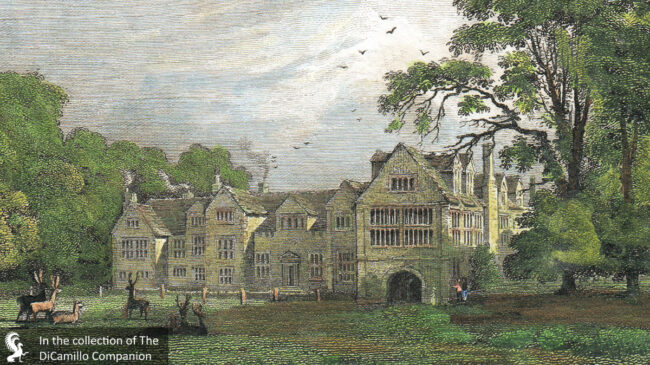
The house from an 1819 hand-colored engraving
Earlier Houses: There was a house on the site of the current house as early as the 11th century.
Built / Designed For: Sir William More
House & Family History: Sir William More, the builder of Loseley, was the son of Sir Christopher More (Sir Thomas More was related to the family by marriage), an official of the Exchequer in the reign of Henry VII and the king's remembrancer. Sir William was knighted by Robert Dudley, Earl of Leicester, acting on behalf of Elizabeth I, at Pyrford, Surrey, on May 14, 1576. Sir William's son, Sir George More, represented Surrey and Guildford in Parliament and was made chancellor of the Order of the Garter by James I. One of Sir George's daughters, Ann, secretly married, at age 17, John Donne, the poet who wrote "never send to know for whom the bell tolls; it tolls for thee" (Dr. Donne also became dean of St. Paul's). Sir George, upon discovering the secret marriage of his daughter, had Dr. Donne thrown out of office and placed in Fleet Prison for a year. Loseley was built to entertain Queen Elizabeth I; both the queen and her successor, James I, were visitors to the house (the drawing room ceiling was gilded especially for James's visit). The unusual chimneypiece in the drawing room is carved from a single block of chalk. Loseley contains stone brought from Waverley Abbey that is more than 850 years old. Part of the original moat still exists and was connected by a now-sealed-off secret passage to the cellars.
Collections: For centuries the Great Hall at Loseley contained the first known portrait of Edward VI as king, painted circa 1548 by an unknown artist (the portrait was one of the stars of "The Treasure Houses of Britain" show at The National Gallery of Art in Washington, DC, in 1985-86). The painting was sold from Loseley to Australian businessman John Schaeffer, who sold this and other paintings at Christie's on June 9, 2004 (the portrait of the king sold for £621,250). The hall contains a marble table on alabaster supports from Nonsuch Palace (made for Henry VIII) that features the Tudor rose and the Scottish thistle. The paneling in the Great Hall also came from Nonsuch Palace. Two maid of honour chair cushions in the drawing room are believed to have been embroidered by Queen Elizabeth I. Sir William More was one of the first Englishman of high rank to create a library. Loseley also contains George IV's coronation chair.
Garden & Outbuildings: The 1,400-acre estate includes Piccards Farm, which produces organic vegetables, additive free meats, and organic dairy products and flours.
Architect: John Thorpe
Date: Circa 1600Architect: William More
Date: 1562-68John Bernard (J.B.) Burke, published under the title of A Visitation of the Seats and Arms of the Noblemen and Gentlemen of Great Britain and Ireland, among other titles: 2.S. Vol. II, p. 177, 1855.
John Preston (J.P.) Neale, published under the title of Views of the Seats of Noblemen and Gentlemen in England, Wales, Scotland, and Ireland, among other titles: Vol. IV, 1821.
Country Life: II, 720, 1897. LXXVII, 544, 1935. CXLVI, 802, 894, 1969.
Title: Treasure Houses of Britain, The - SOFTBACK
Author: Jackson-Stops, Gervase (Editor)
Year Published: 1985
Reference: pg. 409
Publisher: Washington, DC: National Gallery of Art (New Haven: Yale University Press)
ISBN: 0300035530
Book Type: Softback
House Listed: Grade I
Park Listed: Not Listed
Current Seat / Home of: Alexander and Sophia More-Molyneux; More-Molyneux family here since 1562.
Past Seat / Home of: SEATED AT CURRENT HOUSE: Sir William More, until 1600; Michael More-Molyneux, late 20th century.
Current Ownership Type: Individual / Family Trust
Primary Current Ownership Use: Private Home
House Open to Public: Yes
Phone: 01483-304-440
Fax: 01483-302-036
Email: [email protected]
Website: https://www.loseleypark.co.uk/
Historic Houses Member: Yes